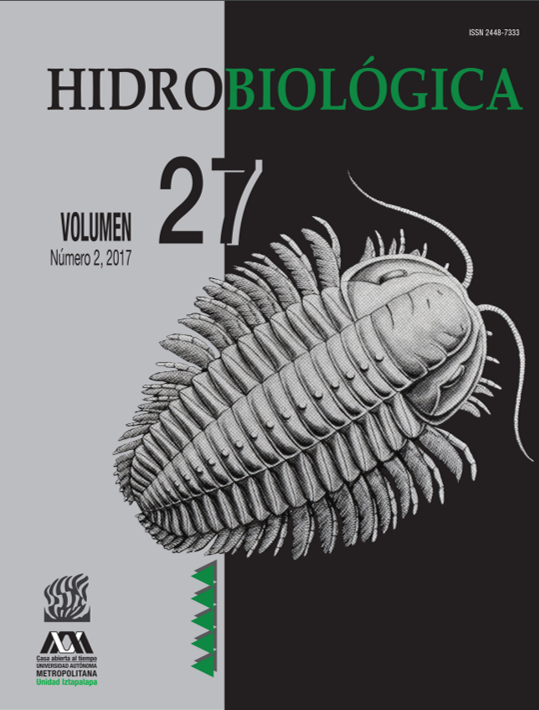Oxidative stress, lipid metabolism, and neurotransmission in freshwater snail (Pomacea patula) exposed to a water-accommodated fraction of crude oil
Keywords:
Crude oil, fatty acid metabolism, neurotransmission, oxidative stress, snails.Abstract
Background. Crude oil is a super mixture of chemical compounds and is commonly found in aquatic environments. The tegogolo (Pomacea patula Baker, 1922) is a Mexican freshwater snail endemic to Lake Catemaco in Veracruz; currently, however, its distribution has expanded to many freshwater ecosystems that suffer the impact of crude oil spills and oil byproducts like fuels. Goals. To assess a series of biomarkers involved in oxidative stress, neurotransmission, and fatty acid metabolism in tegogolos exposed to the water-accommodated fraction (WAF) of Maya crude oil (MCO). Methods. Tegogolo specimens were exposed to WAF of MCO obtained from loads of 0.1, 1, 10 and 100 mg/L. We evaluated ROS ( O2 -* and H2O2), oxidative stress (TBARS and RC=O), enzymes involved in antioxidant defense (SOD, CAT, and GPx), some enzymes involved in neurotransmission (AChE, GDA, and CbE activities), and biomarkers of fatty acids metabolism (fatty acids levels and AOX activity). Results. Clear biomarkers responses were observed only in some tissues. ROS were clearly higher than controls in the foot, head, and kidney; however, others biomarkers of oxidative stress remain statistically unchanged. SOD response was irregular with respect to controls and treatments. In contrast, CAT (foot) and GPx (foot and intestine) were the more active enzymes and their activities were higher than in controls. The responses of some enzymes involved in neurotransmission suggest that compensation mechanisms exist between AChE and GDA in the foot and head. Fatty acids metabolism increased with exposure to WAF; however, these types of biomarkers seem unsuitable for monitoring the toxic effects produced by WAF at low environmental concentrations. Conclusions. We can conclude that under the exposure conditions discussed herein, the tegogolos showed acclimation to WAF of Maya crude oil by complex mechanisms.Downloads
Published
How to Cite
Issue
Section
License
Los autores/as que publiquen en esta revista aceptan las siguientes condiciones:
De acuerdo con la legislación de derechos de autor, HIDROBIOLÓGICA reconoce y respeta el derecho moral de los autores, así como la titularidad del derecho patrimonial, el cual será cedido a la revista para su difusión en acceso abierto.
Publicar en la revista HIDROBIOLÓGICA tiene un costo de recuperación de $500 pesos mexicanos por página en blanco y negro (aproximadamente 29 dólares americanos) y $1000 pesos por página a color (aproximadamente 58 dólares americanos).
Todos los textos publicados por HIDROBIOLÓGICA sin excepción se distribuyen amparados bajo la licencia Creative Commons 4.0Atribución-No Comercial (CC BY-NC 4.0 Internacional), que permite a terceros utilizar lo publicado siempre que mencionen la autoría del trabajo y a la primera publicación en esta revista.
Los autores/as pueden realizar otros acuerdos contractuales independientes y adicionales para la distribución no exclusiva de la versión del artículo publicado en HIDROBIOLÓGICA (por ejemplo incluirlo en un repositorio institucional o publicarlo en un libro) siempre que indiquen claramente que el trabajo se publicó por primera vez en HIDROBIOLÓGICA.
Para todo lo anterior, el o los autor(es) deben remitir el formato de Carta-Cesión de la Propiedad de los Derechos de la primera publicación debidamente requisitado y firmado por el autor(es). Este formato se puede enviar por correo electrónico en archivo pdf al correo: enlacerebvistahidrobiológica@gmail.com; rehb@xanum.uam.mx (Carta-Cesión de Propiedad de Derechos de Autor).
Esta obra está bajo una licencia de Creative Commons Reconocimiento-No Comercial 4.0 Internacional.


